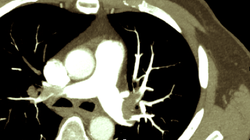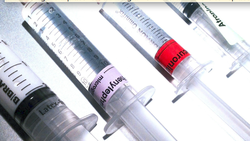 According to the American College of Chest Physicians (ACCP) guidelines thrombolytic therapy is not recommended for most patients (grade 1B). One reason is that controlled clinical trials have not demonstrated benefits in term of reduced mortality rates or earlier resolution of symptoms when currently compared with heparin. Another reason is that thrombolysis with tPA carries a substantial risk for severe complications like intracerebral haemorrhage. Currently accepted indications for thrombolytic therapy include hemodynamic instability or right ventricular dysfunction demonstrated on echo. Although not scientifically proven, quite a few cardiologists will argue that thrombolysis will benefit in better clinical long term outcome by experience. The question remains whether thrombolysis is underutilized and might improve outcomes in moderate PE’s as well. In this publication in Clinical Cardiology Mohsen at al. present an interesting concept of applying a ‘safe dose thrombolysis’ (SDT) where half the dose of tPA is given in conjunction with a modified dose of parenteral anticoagulation... rivaroxaban in this case. Over 12 months 98 patients with moderate to severe PE were treated with this regimen. They come to the conclusion that safe dose thrombolysis plus rivaroxaban was highly safe (no bleeds, recurrent VTE in 3 patients) and effective, leading to favorable early and intermediate-term outcomes and early discharge. Despite some limitations in this publication the idea is interesting indeed and might be a first step towards a new approach towards thrombolysis. Sharifi M et al. Clin Cardiol. 2014 Feb;37(2):78-82  In this recently published Brief Report in the Journal of Academic Emergency Medicine Patanwala et al. looked retrospectively at first pass intubation success by comparing Ketamine to Etomidate. The final cohort included 2098 patients and even after adjusting for potential confounders there was no difference in success rates between the two drugs. In regards of recent discussions on the safety of Etomidate (e.g. adrenal suppression) this study seems to be another puzzle piece favoring other induction agents than Etomidate. Looking at recent publications on paralyzing agents and personal experience I feel that Ketamine and Rocuronium is a favorable combination for rapid sequence inductions in the ICU... what do you think? Patanwala A et al.Academic Emergency. 2014 Feb Curley J et al. Critical Care. 2011,15:190 Marsch SC et al.Crit Care. 2011 Aug 16;15(4):R199  Nutrition in critically ill patients remains a topic often discussed and often debated on. The input you will get by all sorts of different experts is almost endless and I sometimes got the impression we don’t know that much after all. This short article in Intensive Care Medicine of this month (e-published in Nov. 2013) very nicely shows you what we at least believe at this moment to be the truth about nutrition in the ICU. It’s nice and short and gives a very good overview on our current knowledge in this field... ... an excellent introduction for physicians entering the area of Intensive Care for the first time. Singer P et al.Intensive Care Med. 2014 Feb;40(2):252-5 Take Home Messages:
 Since the FDA’s approval of Propofol in 1993 it has become one of the most important drugs used in anaesthesia. It’s properties (short induction time, short half life) have made it an ideal agent for the use in theatre. Also in critical care Propofol was increasingly used for long term sedation and it’s anti-epileptic properties have been welcomed by intensivists treating patients with status epilepticus. In 1992 T.J. Parke et al. published for the first time an article in the BMJ describing 5 children who developed increasing metabolic acidosis, brady-arrhythmia and progressive myocardial failure while sedated with Propofol - today often referred as the Propofol Infusion Syndrome (PRIS). This rare complication shows a complex pathophysiology which is still not fully understood and still continues to be controversially discussed. While initially described in children and traumatic brain injury it is also increasingly reported in other critically ill patients. If you are interested in some background information on this syndrome this recent case report by Mayette et al., published in the Annals of Intensive Care, provides an interesting insight in this topic. Parke et al. BMJ. 1992;305:613 Mayette M. et al. Ann Intensive Care. 2013 Sep 23;3(1):32 Take Home Message: Risk factors for PRIS appear to be...
|
Search
|


 RSS Feed
RSS Feed


